Post-war use of guided anti-tank and anti-aircraft missiles created in Nazi Germany
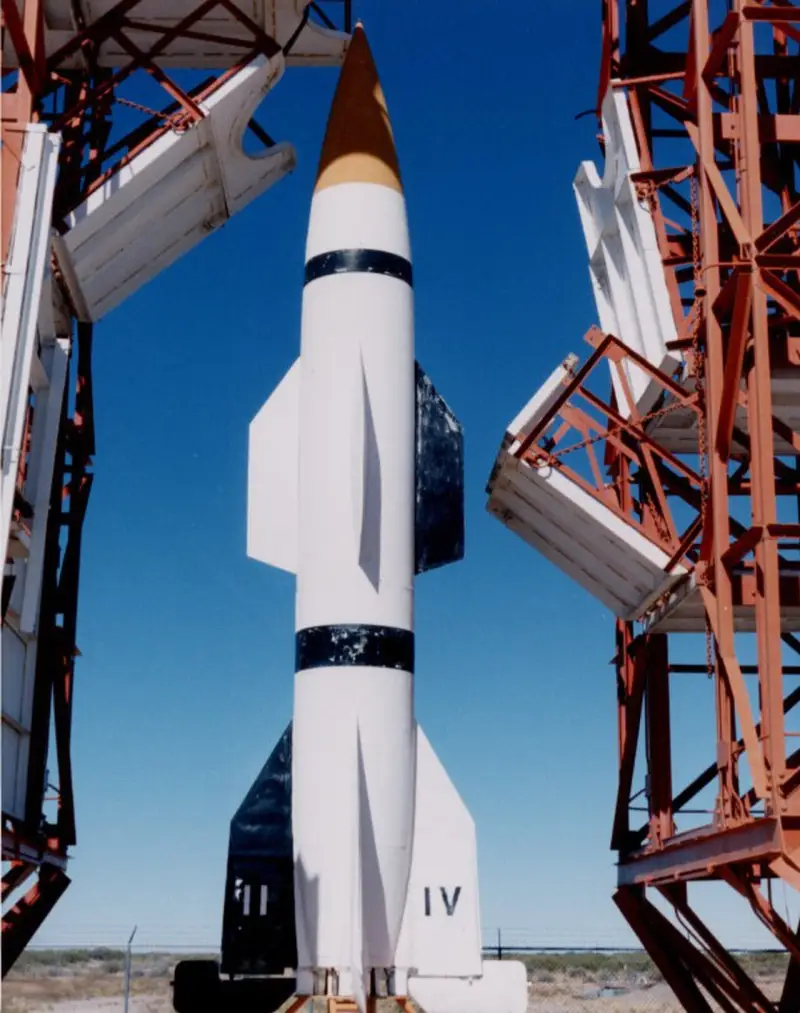
Right up until the surrender of the Third Reich, German designers were creating guided missiles designed to destroy tanks and enemy aircraft. A number of samples were embodied in metal, tested and had a high degree of readiness for launch into mass production.
After the end of World War II, captured ATGMs and missiles were tested at the training grounds of the victorious countries, and some German guided missiles were further developed, and on their basis systems were created that were put into service or used for experimental purposes.
Anti-tank guided missile Ruhrstahl X-7 "Rotkappchen"
Before the start of World War II, the caliber of anti-tank guns did not exceed 47 mm. These were relatively simple, inexpensive and compact guns that the crew could roll on their own without the use of additional traction. But it soon became clear that to reliably destroy tanks with anti-ballistic armor, larger artillery systems were required, the cost and weight of which grew in proportion to the increase in caliber, barrel length and ammunition power.
A very promising direction was the use of cumulative projectiles, the armor penetration of which did not depend on the speed of encounter with an obstacle. In addition to recoilless rifles, reusable and disposable anti-tank grenade launchers, Germany was developing the Ruhrstahl X-7 guided anti-tank missile, which is also known as “Rotkappchen” - “Little Red Riding Hood”.
A project for such a rocket was proposed in 1941 by Raketenabteilung, a structural division of the BMW concern. However, the initiative did not find understanding among officials of the Imperial Armaments Directorate, who refused to finance a project that did not guarantee 100% success and rapid adoption, which was prohibited by Hitler's order. As a result, practical work on “Little Red Riding Hood” began only in 1943, and the main developer was Ruhrstahl AG.
When creating the X-7 anti-tank missile, Ruhrstahl specialists took as a basis the Ruhrstahl X-4 air-to-air missile, which at that time was in a high degree of readiness.
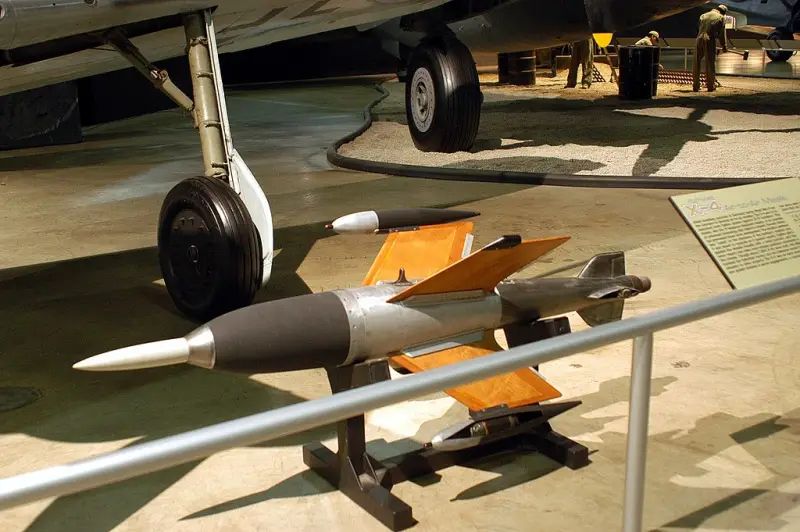
German air-to-air missile Ruhrstahl X-4, on display at the National Museum of the United States Air Force
As in aviation the X-4 missile, in the X-7, intended for firing at armored vehicles, control commands were received via two insulated wires, the coils with which were located in the wingtips. The wings with a span of 60 cm had a backward sweep. Direct guidance was carried out visually using tracers using a control handle - a joystick (the “three-point” method: operator - missile - target).
The rocket's flight was adjusted both vertically and horizontally by control surfaces located on a beam moved back. Flight stabilization was provided by gyroscopes. Sources claim that the rocket's axial rotation speed was two revolutions per second. However, given the location of the tail, this seems doubtful.
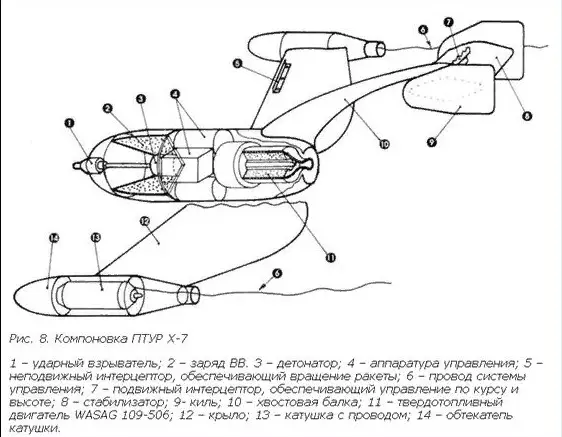
It must be said that the unusual aerodynamic shape with a large wing span, reminiscent of an airplane, was not optimal for ATGMs, which ultimately led to serious difficulties during development. A cross-wing design similar to the Ruhrstahl X-4 air-to-air missile would be much more suitable.
The total length of the rocket was 950 mm. Case diameter – 140 mm. Fully equipped, “Little Red Riding Hood” weighed about 9 kg. To launch and maintain cruising flight speed, solid fuel engines from WASAG were used. The starting engine with a charge of fast-burning diglycol gunpowder weighing 3 kg and a thrust of about 65 kgf worked for 2,5 s and accelerated the rocket to 98 m/s. Simultaneously with the starting engine, a powder gas generator was launched, which, using a turbine, spun the rocket's gyroscopes. The main engine, which developed a thrust of about 5 kgf, operated for 8 s. The average flight speed along the trajectory was approximately 80 m/s. Firing range - up to 1200 m. The launch was carried out with a rail-type guide mounted on a tripod. The weight of the launcher without ATGM is 15 kg.

The destruction of armored targets was ensured by a cumulative warhead weighing 2,5 kg, which was detonated by a piezoelectric fuse. Armor penetration at an angle of 30° – up to 200 mm.
Testing at the Sennelager test site began on September 21, 1944. A total of 7 missiles were fired. The first launches were unsuccessful: operators who did not have the necessary skills drove the rockets into the ground after the launch. Engine explosions occurred on two missiles, and only one hit a target located at a distance of 500 m.
Without waiting for the completion of the ATGM development, it was decided to establish mass production of the “Little Red Riding Hood” at the Ruhrstahlwerke in Brakwede and Mechanische Werke in Brandenburg. In total, we managed to assemble about 300 missiles. A number of sources claim that they could have been used at the final stage of the war, but there are no facts to confirm this.
German experts understood that the X-7 anti-tank missile had a number of significant shortcomings, and in parallel with testing the basic modification, the development of improved versions was carried out.
The ATGM, designated Steinbock (“Capricorn”), was supposed to have a remote control system using infrared rays, and there was no need for wires.
The variant, known as Pinsel (“Paint Brush”), was supposed to be equipped with a semi-automatic guidance system, in which the operator only needed to hold the sighting mark on the target, and the counting device would automatically bring the missile to the aiming line.
However, taking into account the level of development of electronics and guidance systems, it was hardly possible to realize these ideas in the mid-1940s. It was only in the 1960s and 1970s that all the ideas of German designers were translated into production models.
After the end of the war, German developments on the “Little Red Riding Hood” were used to create guided anti-tank missiles in France and the Soviet Union.
The first to achieve success were specialists from the French company Nord Aviation. The ATGM, which entered service in 1955, was designated Nord SS.10 (originally Nord Model 5203). The abbreviation "SS" stands for "Surface-to-Surface Missiles", that is, a surface-to-surface missile.
Although the French significantly redesigned the layout and aerodynamic design of the rocket, the guidance system was similar to that used on the German Ruhrstahl X-7.
After launch, the SS.10 ATGM unwound two thin wires, through which control signals were transmitted from the operator’s joystick. Commands were received on control surfaces, made in the form of spoilers, on the trailing edges of the rocket's wings. The deflection of the interceptors was carried out by an electromagnetic drive. The missile was tracked using a tracer installed on it. Average flight speed is 80 m/s. The missiles were delivered to the position in a light tin box, which also served as a launcher. The mass of the rocket together with the box was 19 kg, which made it possible for one person to carry it.
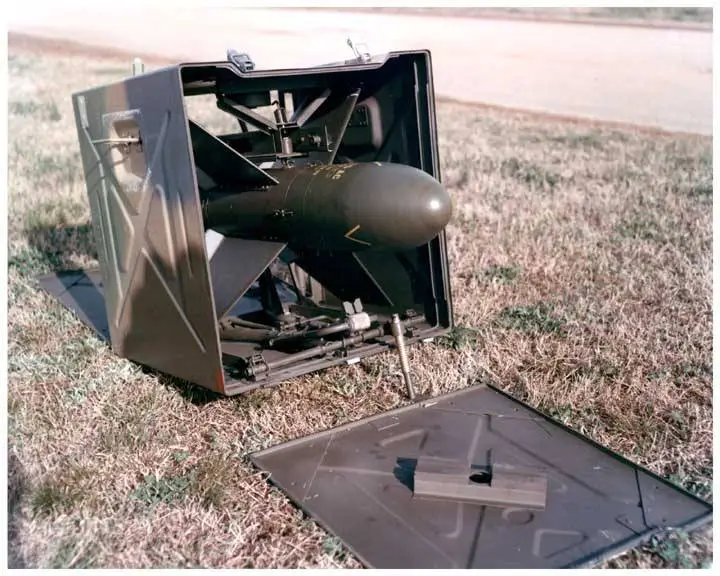
ATGM SS.10 on the launcher
With a launch weight of 15 kg, the firing range was in the range of 300-1600 m. The length of the rocket was 860 mm, the body diameter was 165 mm, and the wingspan was 750 mm. A cumulative warhead weighing 5 kg, when hit along the normal line, could penetrate 400 mm homogeneous armor. The crew consisted of 4 people: a gunner, also known as the crew commander, the driver of the jeep in which the ATGM was transported, and two assistants.
At the training ground, experienced operators hit 70% of targets. However, in a real combat situation, the probability of defeat was approximately half that. In addition, due to the low flight speed of the ATGM manually controlled using a joystick, the enemy tank had a good chance of dodging the missile. However, this was typical of all first-generation anti-tank missile systems.
From 1955 to 1962, almost 30 SS.000 ATGMs were produced, which, in addition to France, were adopted by 10 countries. Licensed production of missiles and equipment was carried out in the USA (under the designation MGM-36), Germany, Norway and India.
The French armed forces used the SS.10 during combat operations in Algeria and Southeast Asia. Since the partisans did not have armored vehicles, they fired at manpower and fortifications.
In 1956, an improved ATGM Nord SS.11 appeared, which differed from the first version in its larger dimensions, weight and high flight speed.
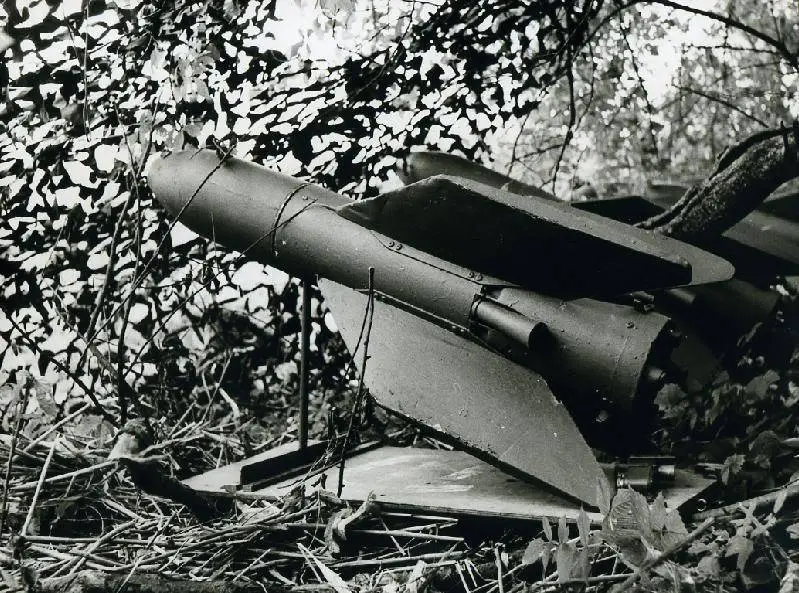
ATGM SS.11 on the launcher
The SS.11 missile, with a length of 1190 mm and a wingspan of 500 mm, weighed 30 kg. The cumulative warhead weighing 6,8 kg penetrated 500 mm armor. At a maximum flight speed of 190 m/s, the maximum firing range was 3000 m. Like the previous model, this ATGM was manually aimed by the operator when the burning tracer installed in the tail section needed to be aligned with the target projection. A well-trained operator at a firing range hit 10 targets with 7 missiles.
However, the SS.11 missile system has hardly taken root anywhere as an infantry anti-tank weapon. This was primarily due to the weight and dimensions of the guidance equipment and ATGMs.
The AS.11 aircraft guided missile became much more widespread, which, in addition to a cumulative warhead, could be equipped with a fragmentation and “anti-material” warhead.
The first carrier of AS.11 missiles was the light twin-engine transport aircraft Dassault MD 311 Flamant. During the Algerian War, these vehicles were used for reconnaissance and bombing of rebel positions. The aircraft with a maximum take-off weight of 5650 kg reached speeds of up to 385 km/h. At least one such aircraft was prepared for the use of AS.11 missiles. The guidance operator's workplace was located in the glazed bow.
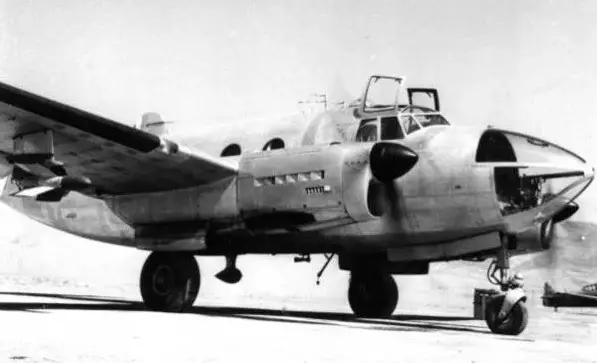
Aircraft MD 311 with suspended AS.11 ATGM
Later, the AS.11 ATGM was also armed with the French Alouette II helicopters and the American UH-1B Iroquois. In the US Army, this missile was designated AGM-22.
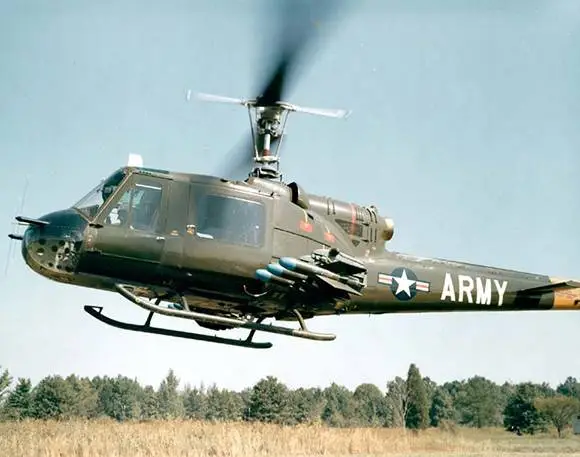
Anti-tank helicopter UH-1В Iroquois, armed with AGM-22 ATGM
In the late 1960s, the Americans tried to use UH-1B Iroquois helicopters with AGM-22 ATGMs against Soviet and Chinese-made armored vehicles in Vietnam. However, the result was unsatisfactory. Due to the fact that reliable guidance of a manually controlled anti-tank missile required highly qualified and trained operators, and the launches themselves often took place under enemy fire, the effectiveness of the AGM-22 was low. Of the 115 AGM-22s launched, only 20 hit the target. As a result, the military preferred the BGM-71 TOW ATGM, albeit relatively expensive, but much more accurate and easy to use. The AGM-22 missile was finally withdrawn from service in 1976.
In turn, the French decided to improve the control system while maintaining the basic design of the rocket. In 1967, based on the AS.11, the Harpon ATGM with the SACLOS semi-automatic guidance system was created. When using this system, it was enough for the operator to keep the target in the crosshairs of the sight, and the automation itself brought the missile to the line of sight. Thanks to this, it was possible to significantly increase the probability of a hit, and the effectiveness of shooting was no longer so dependent on the human factor. The use of the SACLOS system breathed new life into the aging AS.11 missile, and its production continued until the early 1980s. In total, about 180 missiles were delivered, which were in service in more than 000 countries. The AS.40 and Harpon ATGMs were also carried by the French Alouette III helicopters, early versions of the SA.11 Gazelle and the British Westland Scout.
In the Soviet Union, the information obtained from studying the captured “Little Red Riding Hood” was used in the creation of the Shmel ATGM. In 1957, this work was entrusted to the team of the Special Design Bureau (SKB) located in Kolomna, headed by B.I. Shavyrin, who had previously been involved in the development of mortar weapons. The creation of the control system for the complex was entrusted to the Moscow Central Research Institute-173, which had extensive experience in the development of steering drives and remote control systems for various purposes.
After a preliminary consideration of various design, layout and functional schemes, it was decided to settle on an option that actually repeated the technical appearance of the French Nord SS.10 rocket. This was argued by the fact that the use of foreign experience was supposed to reduce the technical risk when creating the first samples of a fundamentally new guided anti-tank weapon. weapons.
The Soviet anti-tank missile 3M6 had a “tailless” design with an X-shaped arrangement of four wing consoles. The cumulative warhead was attached with an easily removable connection to the front hardware compartment of the hull, which housed the on-board battery, two coils of wires through which guidance commands were received, and a control unit. The control unit included receiving equipment, consisting of two amplifiers, and a gyroscopic unit, which provided control and roll stabilization. The gyroscope was spun up before the rocket was launched from a ground-based power source, and during flight it rotated by inertia. The coil was a reel with a bimetallic (steel and copper) cable, the length of which was 500 m greater than the maximum range. The rear part of the hull was occupied by fuel bombs for the sustainer and booster engines with a nozzle. The rocket had four large stabilizers with rudders on their trailing edge. The deflection of the rudders was carried out by electromagnets. In a plane free from roll interceptors, two tracers with different luminosity levels were installed. One of them, selected depending on the lighting conditions of the area, was used to track the missile.
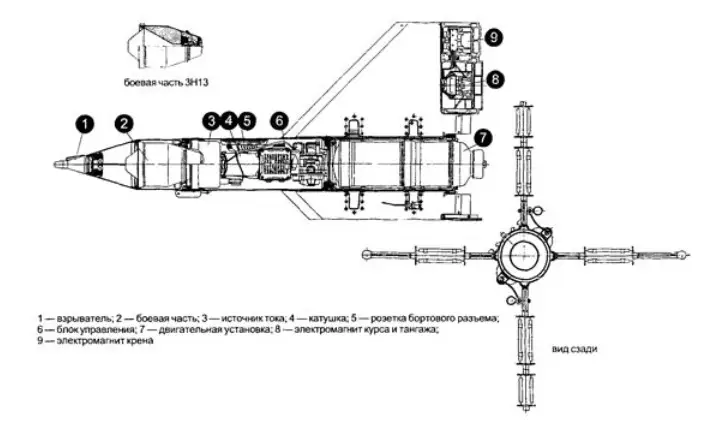
Layout diagram of the 3M6 anti-tank guided missile
The guidance equipment included an operator's console, which monitored the target and the projectile through a binocular sight and issued control commands by deflecting the handle on the console at an angle of up to 40° in any direction. In order to avoid a collision of the rocket with the ground during the first seconds after launch, it was controlled according to the operator’s commands only in the horizontal plane, and in the vertical plane it worked out the programmed trajectory with access to the line of sight “operator - target”.
The rocket with a launch mass of 26 kg had a length of 1170 mm, a diameter of 170 mm, and a tail span of 690 mm. A cumulative warhead weighing 3,3 kg normal ensured penetration of homogeneous armor 300 mm thick. The firing range was in the range of 600-2000 m.
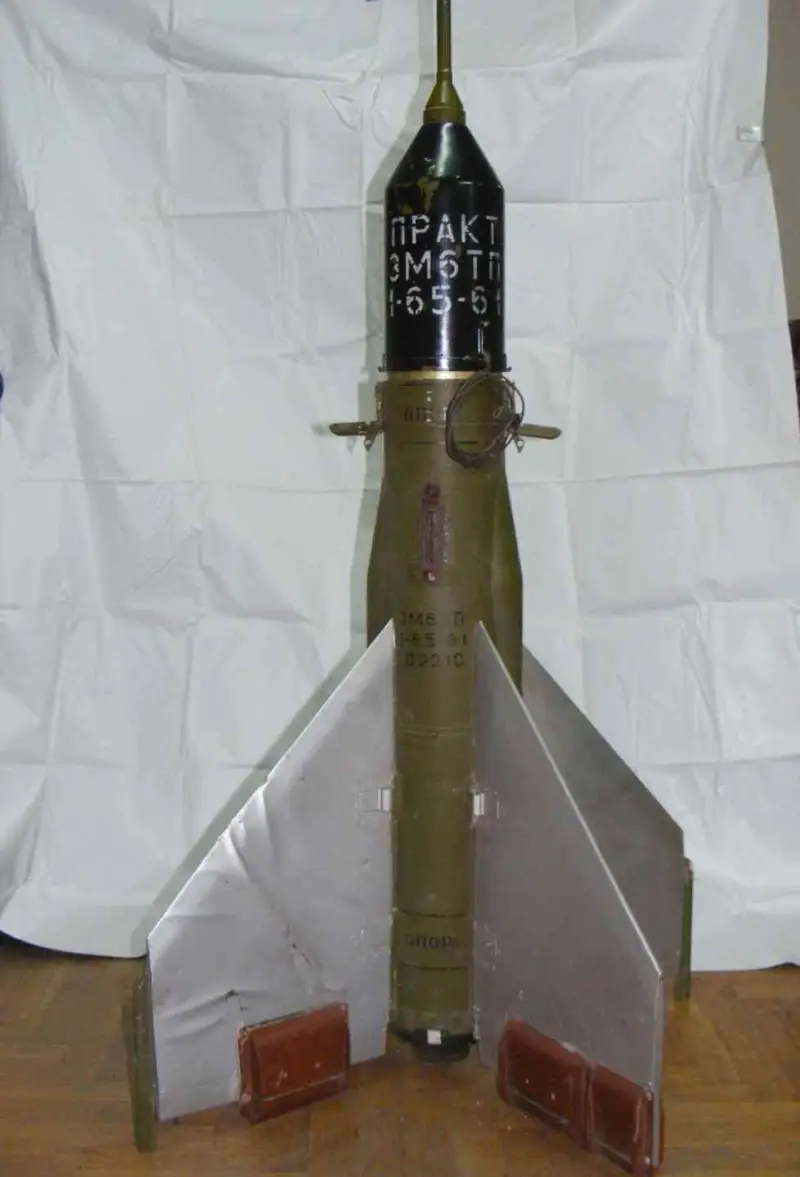
3M6 missile with inert warhead
At the first stage, a portable version of the Shmel ATGM was developed, but since the mass of the complex, which consisted of the missiles themselves, the launcher, batteries and guidance equipment, was too large and required the involvement of 20 soldiers to carry it, they decided to make it self-propelled.
The 2P26 self-propelled gun based on the GAZ-69 was equipped with a launcher with four guides, oriented toward the rear side of the vehicle in the combat position, and directed upward in the transport position.

Self-propelled gun 2P26 based on GAZ-69 in combat position
The combat crew of the 2P26 installation consisted of 2 people. The time for transition to the combat (traveling) position is 1 min 40 s, for shooting with a remote control – up to 2,5 min.
The 2P27 self-propelled gun, based on the BRDM-1 armored reconnaissance and patrol vehicle, had a launcher with three ATGMs that could be raised in the combat position. There were three more spare missiles inside the vehicle.
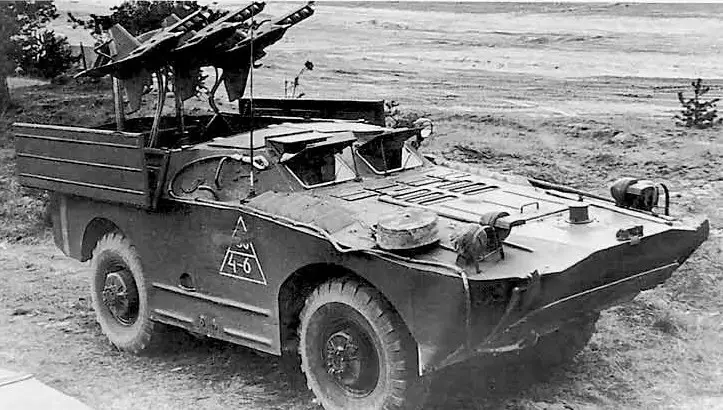
Self-propelled gun 2P27 based on BRDM-1 in combat position
The combat crew of the 2P27 installation also consisted of 2 people. Transition time to firing position is 2 minutes 10 seconds, reloading time is up to 20 minutes.

Under ideal range conditions, experienced operators managed to hit the target with 8 out of 10 missiles. But in a combat situation, no more than 25% of launches were effective.
The adoption of the Shmel ATGM with two types of self-propelled launchers took place in 1960. It was not possible to find data on the number of complexes built. But it is reliably known that the missiles were produced until 1966. In the Soviet Army, complexes of this type were used until the second half of the 1970s. Although the Shmel anti-tank complex did not have high characteristics, it allowed us to accumulate operating experience and practice techniques for using anti-tank complexes with guided missiles.
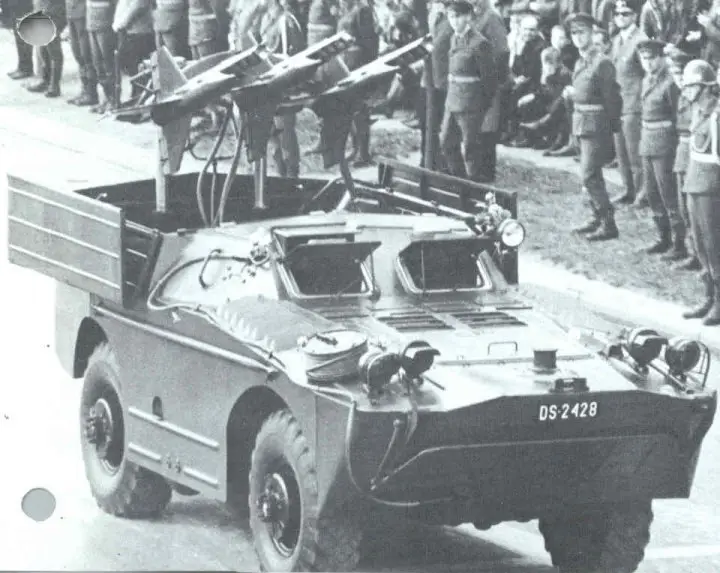
The Shmel ATGM was actively exported and was in service in Algeria, Bulgaria, Hungary, East Germany, Egypt, Cyprus, Cuba, North Korea, Mongolia, Romania, Czechoslovakia and Yugoslavia. These were mainly complexes based on the GAZ-69, but the Warsaw Pact allies also received vehicles based on the BRDM-1. Operation of self-propelled systems 2P26 and 2P27 outside the USSR continued until the end of the 1980s.
The Bumblebee ATGM was used by the Greek Cypriots during the 1974 Turkish invasion. This complex has at least one Turkish M47 tank.
The Egyptian army used the Bumblebee during the 1967 Arab-Israeli War. It is not known for certain whether the Egyptian ATGM operators managed to achieve any success, but more than 20 serviceable 2P26 vehicles with a supply of missiles were captured by the Israelis.
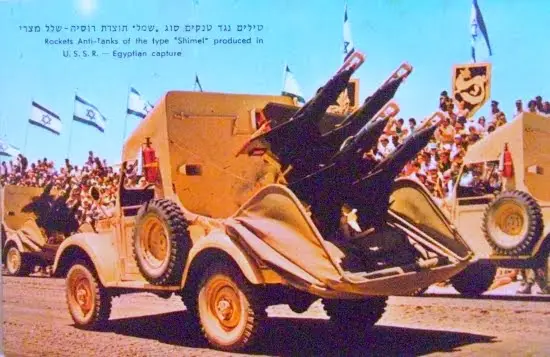
In 1974, the Israel Defense Forces lost most of the Bumblebee anti-tank systems during combat operations. According to available information, captured anti-tank systems were destroyed as a result of artillery shelling.
Wasserfall C2 anti-aircraft guided missile
During the Second World War, several types of anti-aircraft missiles were developed in Germany, and the project known as “Wasserfall” - “Waterfall” - advanced the most.
Theoretical research within the framework of this project began in 1941. In November 1942, a technical design for an anti-aircraft missile appeared, and in March 1943, the first test launch of the prototype took place at the Peenemünde missile site.
English-language sources claim that the creation of Wasserfall C2 largely used technical solutions implemented in the A-4 (V-2) ballistic missile. But the anti-aircraft missile became significantly smaller, and its liquid-propellant jet engine worked on components with which the missile defense system could carry out combat duty for some time.
Red fuming nitric acid was used as an oxidizing agent. The oxidizer fuel tank was designed for 1500 kg. The fuel was vinyl isobutyl ether. Fuel tank capacity – up to 450 kg. When the oxidizer came into contact with the fuel, spontaneous ignition occurred. To safely store the aggressive oxidizer, its tank had an internal polymer coating that prevented contact with metal. But even with this measure, the storage time for a fueled rocket was several days.

Wasserfall rocket layout. The numbers indicate: 1 – fuel tanks, 2 – high-pressure ball cylinder, 3 – intake, 4 – flexible element, 5 – wings, 6 – stabilizers, 7 – air rudders, 8 – gas rudders, 9 – control devices
To make the anti-aircraft missile lighter and cheaper, German engineers abandoned pumps and used a displacement system for supplying fuel components. Nitrogen, compressed in a cylinder to 200 atmospheres, displaced the oxidizer and fuel from the tanks into the combustion chamber. During the pre-launch preparation of the rocket, the squib was triggered, releasing a special piston, which destroyed the membrane separating the containers with fuel and oxidizer, and also opened the valve of the nitrogen cylinder. After this, the rocket launch could no longer be canceled.
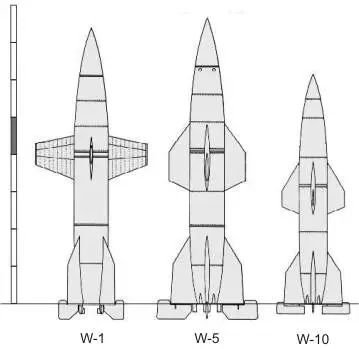
During the development of the Wasserfall missile defense system, modifications W-1, W-5, W-10 were tested. The last of them showed good results. In total, about 50 launches were carried out, of which 14 were considered successful.
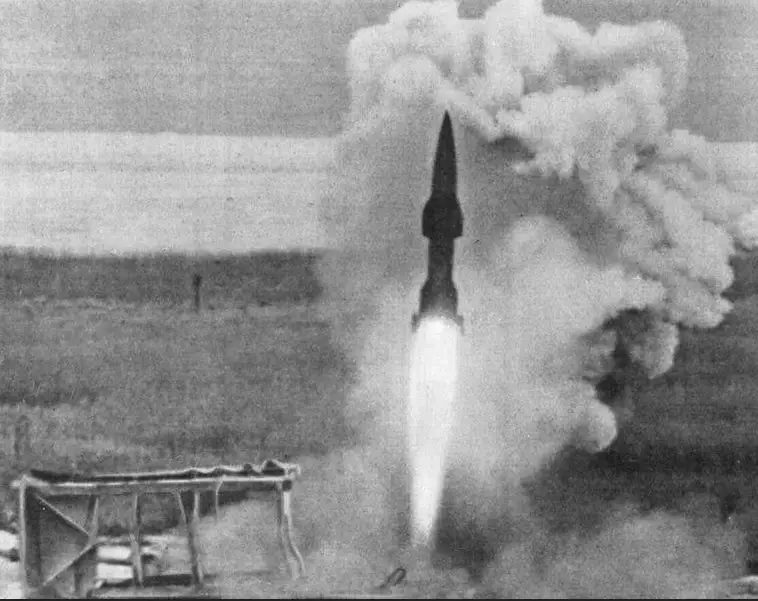
Test launch of the Wasserfall C2 missile defense system in the fall of 1944
The W-10 modification rocket with a launch weight of 3500 kg (according to other sources, up to 3700 kg) had a length of 5080 mm, a body diameter of 698 mm. The tail span is 1580 mm. There are discrepancies regarding the mass of the warhead: some sources claim that serial missiles should have been equipped with a high-explosive fragmentation warhead weighing 235 kg, others say that the weight of the fragmentation warhead did not exceed 90 kg. Perhaps we are talking about different versions of the missile defense system, but personally it seems to me that a 90-kg warhead for a missile with such mass and dimensions was more optimal. During the tests, it was possible to reach a speed of 770 m/s. The altitude reach was 18 km, the maximum controlled flight range was 25 km.
Flight testing and development of the vertically launched missile system were generally completed by November 1944. However, placing the complex on combat duty was hampered by the unavailability of the guidance system.
Initially, it was planned that the operator, monitoring the missile visually, with the help of a clip and a radio command transmitter, was supposed to ensure the proximity of the missile defense system to the target, and the detonation of the warhead occurred at the command of the radio fuse.
Another option provided for the flight of the missile defense system in the radar beam, stabilizing its flight in an equal-signal region (“saddled beam”).
To ensure confident shooting in the dark and in bad weather, we settled on an option in which one radar tracked the target, and the second radar accompanied the missile. The operator, observing two marks on the screen, combined them using the control knobs. The commands were processed by a computing device and transmitted via radio to the rocket. The control equipment was largely the same as the FuG 203/FuG 230 “Kehl-Straßburg” radio command system, which was used to guide the Henschel Hs 293 adjustable bombs.
By March 1945, Wasserfall had been brought to an acceptable level of reliability and efficiency. At the first stage, the Luftwaffe command planned to deploy 200 air defense missile systems to protect cities with a population of more than 100 people. Then the number of complexes was supposed to be increased in order to protect the entire territory of Germany. However, these plans were not even partially implemented, and the Wasserfall combat launches were not carried out.
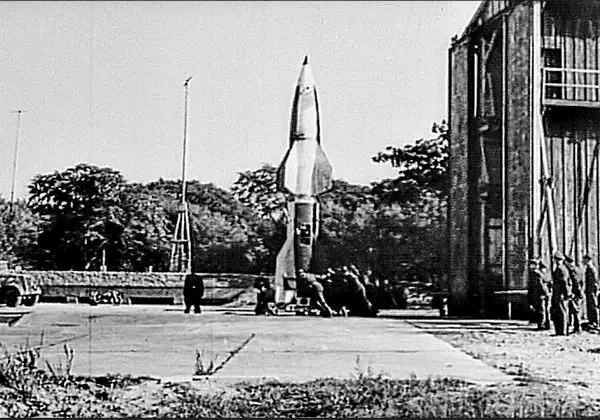
After the surrender of Germany, the winners received several anti-aircraft missiles in varying states of preservation, drawings and test reports. The German rocket men chose to surrender to the Americans.
In 1946, General Electric engineers, who gained access to German developments in missile technology, proposed creating their own anti-aircraft missile based on the Wasserfall. The American copy of Wasserfall C2 was designated Hermes A-1.

Test launch of the Hermes A-1 anti-aircraft missile
Due to organizational and technical problems, the first test launch took place only in February 1951. By that time, the army command had lost interest in this project, since the MIM-3 Nike Ajax air defense system was on its way. In this regard, they tried to convert the successfully tested missile defense system into an operational-tactical missile capable of carrying a nuclear warhead with a yield of 20 kt. However, the military preferred the MGM-5 "Corporal" missile.
In the Soviet Union, work on the Wasserfall continued in the post-war period, and the R-88 rocket was created by NII-101. Since Soviet specialists received only one rocket with the Messina telemetry system and an incomplete set of technical documentation, many rocket components and the launch pad were developed anew. A total of 50 missiles were assembled.
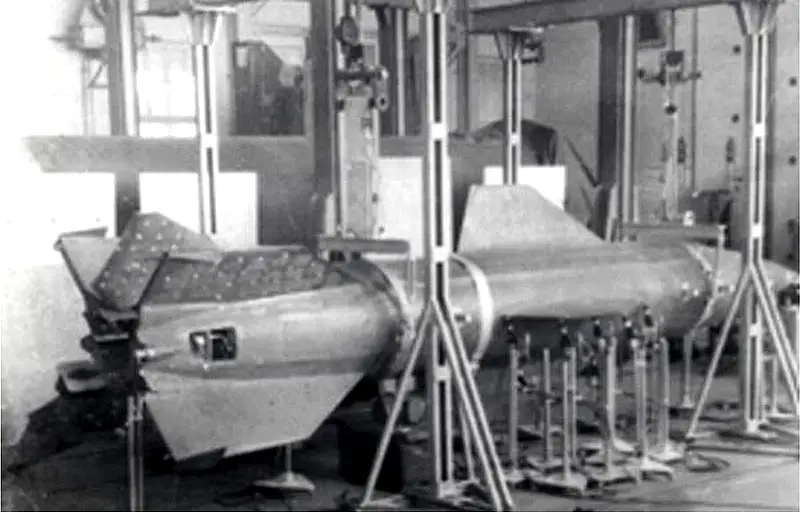
Dynamic tests of the R-101 missile defense system at TsNIIMash
Testing of the R-101 at the Kapustin Yar test site began in January 1949. In total, 14 launches were carried out as part of the first stage tests. Tests of the second stage were carried out in December 1949 and January 1950. These were modifications of the R-101A, R-101B and R-101V missiles, which differed from the first version in equipment and a different type of rocket engine.
Work on the creation of anti-aircraft guided missiles R-101, due to the uncertainty of the prospects for fine-tuning the guidance system to the required level, was stopped in August 1951. The resulting developments were subsequently used to create the R-11 operational-tactical missile.
Продолжение следует ...
Information